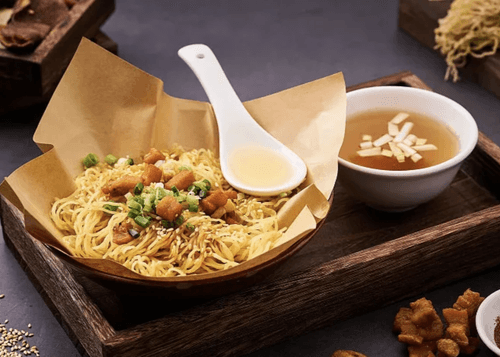
Guangzhou CuiSine — Street & Small-Plate Snacks
Guangzhou’s small-eat scene is where city life and flavor meet — affordable, quick, and very local. These five items give you a good cross-section of the city’s casual eats.
Wonton noodles (云吞面)
How it’s made / seasoning: Thin egg or alkaline noodles in a clear, gently seasoned broth; wontons are thin-skinned parcels filled with shrimp and/or pork. Taste / texture / feature: Clean, umami broth; silky wonton filling; springy noodles. Comfort food that showcases ingredient freshness rather than heavy sauces. Tip for tourists: You can order “dry” (no broth, tossed in sauce) or soup version. Add chili oil if you like heat.
Beef brisket noodles / rice noodles (牛腩粉 / 牛腩面)
How it’s made / seasoning: Beef brisket slow-braised for hours with star anise, cinnamon/Chinese spices and soy, then served with rice noodles or wheat noodles in the aromatic broth. Taste / texture / feature: Rich, savory broth with tender, melt-in-your-mouth beef that carries warm spice notes. Very satisfying and hearty. Tip for tourists: Great for a filling lunch. If you’re sensitive to spice, tell the vendor “mild” — most versions are mild but aromatic.
Boat congee / “ting zai” congee (艇仔粥)
How it’s made / seasoning: A silky rice porridge simmered long and topped with a mix of small seafood (fish slices), pork, peanuts, fried dough, and preserved items. Originated from small boats that sold congee. Taste / texture / feature: Creamy, comforting porridge with bursts of texture from toppings — simultaneously delicate and flavorful. Tip for tourists: Perfect for breakfast or late night. Order a small bowl first to sample the mix of seafood and crunchy toppings.
Xiguan beef offal (西关牛杂) — classic local favorite
What it is / how it’s prepared: “Beef offal” refers to various beef innards — for example tripe, intestine, tendon — that are thoroughly cleaned, blanched, and then slowly stewed with aromatic spices and soy-based seasonings. Safety & taste note (important for foreign visitors): In reputable stalls and restaurants the offal is professionally cleaned and hygienically cooked; it’s not “raw” or risky. The slow cooking removes strong odors and delivers a tender texture. The overall flavor is very close to regular beef — savory, rich, and comforting — but with a variety of textures (chewy tendon, soft tripe, etc.). Taste / texture / feature: Deep, savory broth, complex texture; historically a working-class favorite with lots of street-food culture around it. Tip for tourists: Start with a mixed bowl from a busy, well-reviewed vendor. If innards worry you, ask for primarily tendon or brisket instead. Eating it is a genuine local experience.
Guangdong dessert soups — “Guangdong sweet desserts” (广式糖水)
What it refers to / how it’s made: In Cantonese cuisine, “tong sui” (糖水) refers broadly to a wide variety of small, often soup-like desserts and sweet treats served after a meal or as a light snack. Examples include red-bean soup, sesame paste, mango sago, steamed milk puddings, and many local seasonal specialties. Preparation methods vary — some are simmered (sweet soups), some are steamed or chilled (custards and puddings), and some use ingredients like coconut milk, fresh fruit, beans, or grains. Taste / texture / feature: These desserts are usually lighter and less sugary than many Western desserts; textures range from silky and creamy to chewy or soupy. They are designed to be a gentle, refreshing finish rather than an overpowering sweet course. Tip for tourists: Try a small bowl of a few different tong sui to sample the variety — ask if the dessert is served hot or cold (many are seasonal). If you prefer less sweetness, tell the server “less sugar” (少糖) — vendors will usually accommodate.


